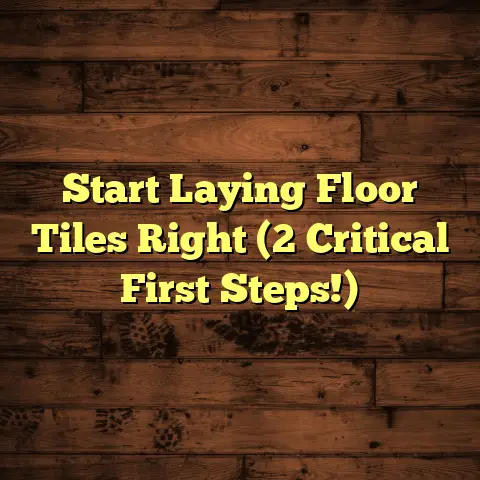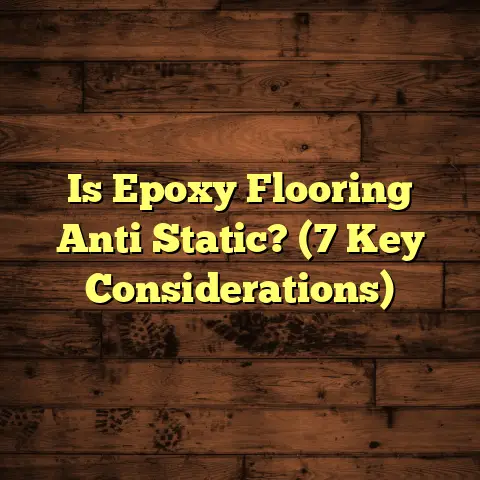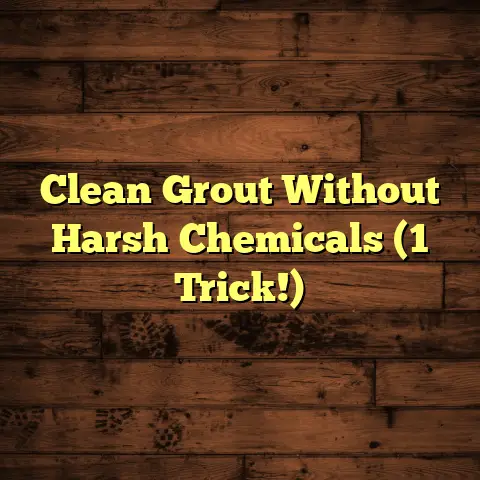Hardwood Beyond Repair? (5 Signs It’s Over!)
What if you walked into your home one day, only to discover that the once-lustrous hardwood floors that graced your living space have transformed into a shadow of their former selves?
The rich grains and warm tones that welcomed you are now marred by deep scratches, unsightly stains, and an overall dull finish.
As you take in the damage, you can’t help but wonder: is this flooring beyond repair?
As a flooring contractor with years of experience, I’ve seen it all. Trust me, it’s not always easy to tell when a floor is truly “done for.”
But don’t worry! In this article, we will explore the five critical signs that indicate your hardwood floors may have reached the point of no return.
Let’s dive in, and I’ll share some of my insider knowledge with you.
Sign 1: Deep Scratches and Gouges
Okay, let’s talk scratches. We’re not talking about those tiny, surface-level scuffs you get from everyday wear and tear. I’m talking about the deep ones.
You know, the kind that make you cringe every time you see them.
Think about it: Heavy furniture being dragged across the floor, your dog’s enthusiastic zoomies, or even just dropping something heavy like a cast iron skillet.
These can all lead to some serious damage.
Now, here’s the thing: a light sanding can often take care of surface scratches. I’ve done it hundreds of times.
But when you’re dealing with gouges that penetrate deep into the wood, compromising its structural integrity, that’s a whole different ball game.
Imagine a deep groove running across several planks. Not only does it look bad, but it also creates a weak point in the floor.
Over time, this can lead to cracking or splintering, especially in high-traffic areas.
Think of it like a small crack in your car’s windshield. If you don’t address it, it’ll eventually spread and become a much bigger problem.
I’ve seen floors where the gouges were so deep that sanding would have removed a significant amount of the wood, making the floor uneven and unstable.
In those cases, replacement was the only viable option.
Key takeaway: If you can’t run your finger across the scratch without feeling a noticeable dip, it’s likely too deep to sand out effectively.
Sign 2: Water Damage and Warping
Water is hardwood’s worst enemy. Period.
Exposure to moisture can lead to some pretty significant damage, including warping, buckling, and cupping.
And trust me, these are not pretty sights.
I’ve seen homeowners face water damage from all sorts of sources. Think about burst pipes, leaky appliances (dishwashers and refrigerators are common culprits), or even just high humidity levels in certain climates.
Flooding, of course, is the ultimate nightmare scenario.
So, what are the visual indicators of water damage?
Well, warping is when the individual planks start to bend and twist out of shape.
Buckling is when the planks actually lift up off the subfloor, creating noticeable humps and bumps.
Cupping, which we’ll talk about in more detail later, is when the edges of the planks rise up, creating a concave shape.
These are all signs that the wood has absorbed too much moisture and is trying to expand.
The problem is, hardwood can only handle so much moisture before it starts to break down.
Once the wood has warped or buckled, it’s extremely difficult, if not impossible, to restore it to its original condition.
I remember one client who had a slow leak under their kitchen sink for months without realizing it.
By the time they discovered the problem, the hardwood flooring in the entire kitchen was severely warped and had to be replaced.
Pro Tip: Always be vigilant about potential water sources in your home and address any leaks or moisture issues immediately.
Sign 3: Extensive Cupping and Crowning
Alright, let’s dive deeper into cupping and crowning, two terms you might hear thrown around in the flooring world.
Cupping, as I mentioned earlier, is when the edges of the hardwood planks rise up, creating a concave or “U” shape.
Crowning, on the other hand, is the opposite: the center of the plank rises up, creating a convex or “humped” shape.
So, what causes these deformities?
Well, both are typically caused by moisture imbalance within the wood.
Cupping usually occurs when the bottom of the plank is wetter than the top, causing the edges to expand more than the center.
This can happen due to high humidity levels in the subfloor or moisture seeping up from below.
Crowning, conversely, often occurs when the top of the plank is wetter than the bottom, perhaps due to a spill that wasn’t cleaned up promptly.
Poor installation can also contribute to cupping and crowning.
If the subfloor isn’t properly prepared or if the planks aren’t acclimated to the home’s humidity levels before installation, it can create an environment ripe for these issues.
Now, how do these issues affect your home?
Well, for starters, they can be a tripping hazard. Those raised edges and humps can catch your feet and cause you to stumble.
Plus, they can make it difficult to clean the floor properly, as dirt and debris can get trapped in the crevices.
And let’s not forget the aesthetic impact. Cupped or crowned floors simply don’t look good. They detract from the overall beauty and value of your home.
I’ve seen floors where the cupping was so severe that you could actually feel the individual planks moving under your feet.
In those cases, there’s really no other option than to replace the entire floor.
Important Note: Minor cupping or crowning can sometimes be corrected by addressing the underlying moisture issue and allowing the floor to acclimate properly. However, extensive damage usually requires replacement.
Sign 4: Stains and Discoloration
Stains are another common enemy of hardwood floors.
Whether it’s from spills, pet accidents, or just everyday wear and tear, stains can be tough to remove.
And some stains are simply irreversible.
I’m talking about those deep-set stains that penetrate into the wood fibers and refuse to budge, no matter how hard you scrub.
Think about red wine, pet urine, or even bleach. These substances can cause permanent discoloration and leave behind unsightly marks.
Pet urine, in particular, is notorious for its ability to soak deep into hardwood and create a lingering odor, even after the stain itself is removed.
And bleach, well, that can strip the color out of the wood entirely, leaving behind a stark, white patch.
But it’s not just major spills that can cause problems.
Even everyday wear and tear can lead to subtle discoloration over time.
Areas that get a lot of sunlight exposure, for example, may fade or yellow, while areas under rugs or furniture may retain their original color.
This can create an uneven, patchwork appearance that detracts from the overall look of the floor.
Now, some stains can be removed with specialized cleaning products or by sanding and refinishing the floor.
I’ve had success with these methods in many cases.
But when the stains are deep-set, widespread, or have caused significant discoloration, replacement may be the only option.
I had one client who tried everything to remove a large red wine stain from their dining room floor.
They scrubbed, they bleached, they even tried home remedies they found online.
But nothing worked. The stain was simply too deep.
In the end, they had to replace the affected planks to restore the floor to its original beauty.
Key Point: If you’ve tried everything to remove a stain and it’s still visible, it’s likely time to consider replacement.
Sign 5: Excessive Squeaking and Movement
Finally, let’s talk about squeaking and movement. While a little bit of squeaking is normal in hardwood floors, excessive squeaking and movement can be a sign of deeper problems.
I’m talking about those loud, persistent squeaks that drive you crazy every time you walk across the floor.
Or those areas where the planks feel loose or unstable under your feet.
These are often indicators of structural issues within the flooring system.
The boards may be loose from the subfloor due to failing nails or adhesives.
Or the subfloor itself may be damaged or uneven, causing the planks to flex and rub against each other.
In some cases, excessive squeaking and movement can even be a sign of more serious problems, such as termite damage or rot.
Now, a few isolated squeaks can often be fixed by adding shims or screws to stabilize the affected planks.
I’ve done this many times with good results.
But when the squeaking is widespread or accompanied by noticeable movement, it’s usually a sign that the entire floor needs to be replaced.
Imagine a floor where every other step is accompanied by a loud squeak or groan.
Not only is it annoying, but it also indicates that the floor is structurally unsound and could potentially collapse.
I’ve seen floors where the movement was so pronounced that you could actually see the planks shifting and separating from each other.
In those cases, there’s no question that replacement is the only safe and sensible option.
Important Consideration: Don’t ignore excessive squeaking and movement in your hardwood floors. These are often warning signs of more serious problems that need to be addressed promptly.
Statistics: According to the National Wood Flooring Association (NWFA), squeaking floors are one of the most common complaints among hardwood flooring owners. (Source: NWFA Technical Manual)
Conclusion
So, there you have it: the five critical signs that your hardwood floors may be beyond repair.
Let’s recap:
- Deep Scratches and Gouges: If the damage penetrates deep into the wood, sanding may not be enough.
- Water Damage and Warping: Warped, buckled, or cupped planks are often irreparable.
- Extensive Cupping and Crowning: Severe deformities can compromise the integrity of the floor.
- Stains and Discoloration: Deep-set stains that cannot be removed may require replacement.
- Excessive Squeaking and Movement: Widespread squeaking and movement can indicate structural issues.
It’s important to recognize these indicators early to prevent further damage and to make informed decisions about flooring replacement.
I encourage you to assess your hardwood floors regularly and seek professional advice when necessary.
While some issues may be manageable with repairs or refinishing, others may sadly signal the end of a beloved floor.
Remember, replacing your hardwood floors can be a significant investment, but it’s often the best way to restore the beauty, value, and safety of your home.
Don’t hesitate to consult with a qualified flooring contractor to assess the condition of your floors and determine the best course of action.
And if you’re ever in doubt, remember: it’s better to be safe than sorry.
Taking proactive steps to address flooring issues can save you time, money, and headaches in the long run.





